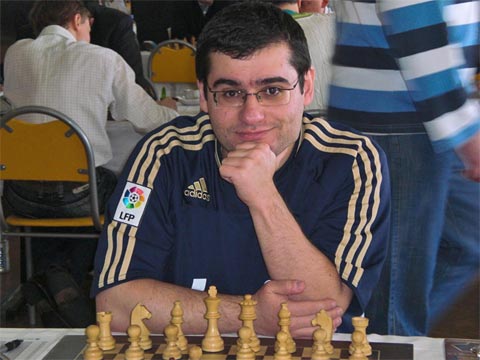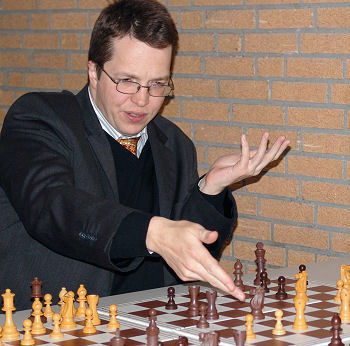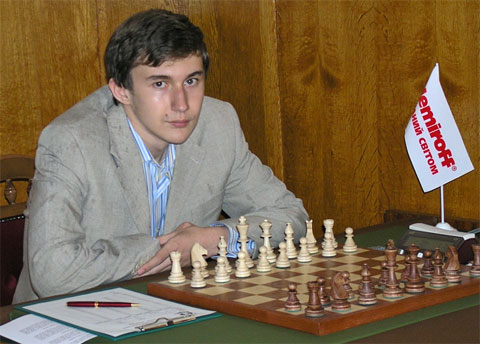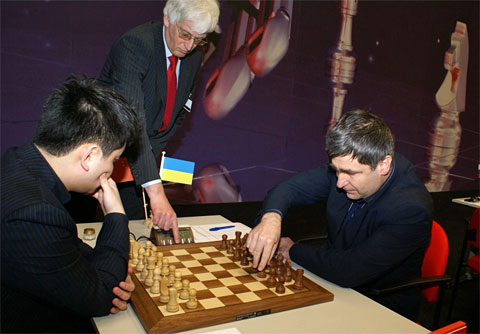| Latest | Greatest | Lobby | Journals | Search | Options | Help | Login |
|
|
|
This topic is archived. |
| Home » Discuss » Topic Forums » Sports |
|
| Jack Rabbit
|
Sun Jan-25-09 08:17 PM Original message |
| The Jack Rabbit Chess Report (January 25): Movsesian Leads in Wijk aan Zee |
|
Edited on Sun Jan-25-09 08:18 PM by Jack Rabbit
Movsesian leads Corus A after 8; Short leads Group B; Tiger has hold of C
 Grandmaster Sergei Movsesian of Slovakia leads the elite group of the annual Corus Chess Tournament with 5 points after 8 rounds of the scheduled 13-round event in the Dutch seaside town of Wijk aan Zee. Movsesian took the lead today in spite of being held to a draw by Dutch national champion Jan Smeets when young Ukrainian GM Sergey Karjakin, who shared the top spot with Movsesian at the start of today's round, lost to his venerable compatriot, Vassily Ivanchuk. Interestingly, Movsesian caught Karjakin in the standings yesterday when he defeated Ivanchuk in 35 moves from the Black side of an Open Sicilian. Karjakin fell to a four-way tie for second place at 4� points each with Teimour Radjabov (Azerbaijan), Levon Aronian (Armenia) and Lenier Dom�nguez (Cuba). In the other sections, former world championship challenger Nigel Short, 43, leads Group B with 5� points over Alexander Motylev of Russian and Ukraine's Andrei Volokitin, who are tied for second with 5 points each. In Group C, Swedish GM Tiger Hillarp Persson has 6 points to lead 15-year-old Filipino prodigy Wesley So by a full point. Tomorrow is a rest day for the players. Round 9 will start Tuesday at 13:30 Central European Time (4:30 am PST). All games in all section will be broadcast live at the official tournament website. Games from the first half of the tournament will be up later this evening. Calendar Gibraltar Chess Festival 27 January-5 February. Moscow Open 30 January-9 February. Aeroflot Open, Moscow 16-27 February. Topalov-Kamsky World Championship Semifinal Match, Sofia 16-28 February. Eight Rounds. Winner will challenge Anand for the world championship. Linares Grandmaaster Tournament 18 February-8 March. Cappelle la Grande Open 28 February-7 March. Reykjavik Open 4-13 March. European Individual Championships, Budva (Montenegro) 5-19 March. Foxwoods Open, Mashantucket, Connecticut April 8-12. MTel Masters, Sofia May 9-19. Aerosvit International Tournament, Foros (Ukraine) June 9-20. |
| Printer Friendly | Permalink | | Top |
| Jack Rabbit
|
Sun Jan-25-09 09:48 PM Response to Original message |
| 1. Games from Wijk aan Zee |
|
Your humble hare acknowledges the assistance of Fritz 6.0 on analysis. Diagrams on the Jack Rabbit Chess Report are made with Chess M�rida, a true type font that can be downlaoded free here. !""""""""# $tMvWlVmT% $OoOoOoOo% $ + + + +% $+ + + + % $ + + + +% $+ + + + % $pPpPpPpP% $RnBqKbNr% /(((((((() WHITE White to move (This position is a theoretical draw) |
| Printer Friendly | Permalink | | Top |
| Jack Rabbit
|
Sun Jan-25-09 09:49 PM Response to Reply #1 |
| 2. Ivanchuk - Movsesian, Group A, Round 7 |
 Sergei Movsesian Vassily Ivanchuk - Sergei Movsesian Corus Chess Tournament (Group A), Round 7 Wijk aan Zee, 24 January 2009 Open Sicilian Game: Scheveningen Defense (Chandler-Nunn Opening) 1.e4 c5 2.Nf3 d6 3.d4 cxd4 4.Nxd4 Nf6 5.Nc3 e6 6.Be3
6...Nc6
7.f4
7...Bd7
8.Be2
8...Be7 9.Ndb5
9...Qb8 10.a4 0-0 11.0-0 Rd8 12.Kh1
12...Nb4!?
13.Bf3
13...e5!?
14.Qe2
14...Bc6 15.fxe5
15...dxe5 16.a5 b6
17.axb6 axb6 18.Rxa8 Bxa8
19.Na4 Bc6 20.c4
20...Nxe4 21.Nxb6 f5 22.Nc3 Qb7
23.c5?!
23...Nd3 24.Bxe4?
24...Bxe4 25.b4 Kh8 26.Rb1
!""""""""# $ + T + L% $+w+ V Oo% $ N + + +% $+ P Oo+ % $ P +v+ +% $+ NmB + % $ + +q+pP% $+r+ + +k% /(((((((() WHITE: Vassily Ivanchuk Position after 26.Rf1b1 26...f4!
27.Bg1 Bg6 28.Nc4 e4 29.Na5
29...Qa8 30.c6 Bxb4 31.Nb7
!""""""""# $w+ T + L% $+n+ + Oo% $ +p+ +v+% $+ + + + % $ V +oO +% $+ Nm+ + % $ + +q+pP% $+r+ + Bk% /(((((((() WHITE: Vassily Ivanchuk Position after 31.Na5b7 31...f3!
32.gxf3 exf3 33.Qxf3
33...Rf8 34.Qd5
34...Bxc3 35.c7 Nf4 0-1
|
| Printer Friendly | Permalink | | Top |
| Jack Rabbit
|
Sun Jan-25-09 09:51 PM Response to Reply #1 |
| 3. Short - l'Ami, Group B. Round 3 |
 Nigel Short Nigel Short - Erwin l'Ami Corus Chess Tournament (Group B), Round 3 Wijk aan Zee, 19 January 2009 Spanish Petit Royal Game: Four Knights' Opening 1.e4 e5 2.Nf3 Nf6 3.Nc3 Nc6 4.Bb5 Nd4
5.Nxe5
5...Nxb5?
6.Nxb5 c6 7.Nc3 Qe7 8.Nf3!
8...Nxe4
9.0-0 Nxc3 10.dxc3 d5 11.Bg5
11...Qd6 12.Re1+ Be6 !""""""""# $t+ +lV T% $Oo+ +oOo% $ +oWb+ +% $+ +o+ B % $ + + + +% $+ P +n+ % $pPp+ PpP% $R +qR K % /(((((((() WHITE: Nigel Short Position after 12...Bc8e6 13.Nd4!
13...c5
14.Nxe6 fxe6 15.Qh5+ g6 16.Qg4 Kf7
17.c4 d4 18.Qf3+ Kg8 19.Bf6 1-0
|
| Printer Friendly | Permalink | | Top |
| Jack Rabbit
|
Sun Jan-25-09 09:52 PM Response to Reply #1 |
| 4. Giri - Hillarp Persson, Group C, Round 5 |
 Tiger Hillarp Persson Anish Giri - Tiger Hillarp Persson Corus Chess Tournament (Group C), Round 5 Wijk aan Zee, 22 January 2009 Slav Queen's Gambit: Tikhi Opening 1.d4 d5 2.c4 c6 3.Nf3 Nf6 4.e3 Bf5 5.Nc3 e6 6.Nh4 Be4
7.f3 Bg6 8.Qb3 b5!?
9.cxd5
9...exd5 10.Nxg6 hxg6 11.Bd2 a5
12.0-0-0 Be7
13.g4 Na6
14.Qc2 a4 15.h4
15...Nb4 16.Qb1 a3
17.b3 Qd6
18.Be2
18...Rc8 19.h5 gxh5
20.gxh5 Qe6 21.f4?
!""""""""# $ +t+l+ T% $+ + VoO % $ +o+wM +% $+o+o+ +p% $ M P P +% $OpN P + % $p+ Bb+ +% $+qKr+ +r% /(((((((() WHITE: Anish Giri Position after 21.f3f4 21...c5!
22.h6
22...Rxh6 23.Rxh6 gxh6
24.Bxb5+ Kd8
25.Bd3
25...cxd4 26.exd4
26...Qh3 27.Bc4
27...dxc4 28.bxc4 Rxc4 29.Qb3 Rc8 30.Be1 Nfd5 31.Qa4 Rxc3+! 1-0
|
| Printer Friendly | Permalink | | Top |
| Jack Rabbit
|
Sun Jan-25-09 10:02 PM Response to Reply #1 |
| 5. Karjakin- Stellwagen, Group A, Round 5 |
 Sergey Karjakin Sergey Karjakin - Daniel Stellwagen Corus Chess Tournament (Group A), Round 5 Wijk aan Zee, 22 January 2009 Open Sicilian Game: Taimanov Defense 1.e4 c5 2.Nf3 e6 3.d4 cxd4 4.Nxd4 Nc6 5.Nc3 Qc7 6.Be3
6...a6 7.Qd2
7...Nf6 8.0-0-0 Bb4 9.f3 Ne5 10.Nb3 b5 11.Qe1
11...Rb8
12.Qg3 Nh5 13.Qf2?
!""""""""# $ Tv+l+ T% $+ Wo+oOo% $o+ +o+ +% $+o+ M +m% $ V +p+ +% $+nN Bp+ % $oOo+ QpP% $+ Kr+b+t% /(((((((() WHITE: Sergey Karjakin Position after 13.Qg3f2 13...Bxc3!
14.Bc5 d5!
15.bxc3
15...Bb7!
16.Qh4 Nf4 17.Qg3
17...Nfg6 18.f4 Nd7 19.Bb4 Qxf4+?
20.Qxf4 Nxf4 21.Bd6
21...Ng6
22.Bxb8 Nxb8 23.Na5 Ba8 24.exd5!
24...Bxd5?
!""""""""# $ M +l+ T% $+ + +oOo% $o+ +o+m+% $No+v+ + % $ + + + +% $+ P + + % $p+p+ +pP% $+ Kr+b+r% /(((((((() WHITE: Sergey Karjakin Position after 24...Ba8d5:p 25.c4!
25...bxc4 26.Nxc4 Ke7 27.Ne3 Bc6
28.Rd4 Ne5 29.Be2 Nbd7 30.Rhd1 Nc5 31.g3?
!""""""""# $ + + + T% $+ + LoOo% $o+ +o+ +% $+ M M + % $ + R + +% $+ + N P % $p+p+b+ P% $+ Kr+ + % /(((((((() WHITE: Sergey Karjakin Position after 31.g2g3 31...Rc8!
32.Nc4
32...Nxc4
33.Bxc4 a5 34.Re1 f6 35.Re3
35...e5 36.Be2 Be8 37.Rh4 h6 38.Ra3 Ra8
39.Rb4 Kd6 40.Bf3
40...Ra7 41.Rb8 Bd7 42.Kd2 e4 43.Be2
43...f5 44.h4 a4 45.Rc3 Rc7 46.a3 g5?
!""""""""# $ R + + +% $+ Tv+ + % $ + L + O% $+ M +oO % $o+ +o+ P% $P R + P % $ +pKb+ +% $+ + + + % /(((((((() WHITE: Sergey Karjakin Position after 46...g7g5 47.Rh8!
47...f4
48.Rxh6+ Ke5 49.hxg5
49...f3 50.Bf1 Bf5 51.Ke3 Na6 52.Rhc6 1-0
|
| Printer Friendly | Permalink | | Top |
| Jack Rabbit
|
Sun Jan-25-09 11:02 PM Response to Reply #1 |
| 6. So - Le�n Hoyos, Group C, Round 6 |
 Wesley So Wesley So - Manuel Le�n Hoyos Corus Chess Tournament (Group C), Round 6 Wijk aan Zee, 23 January 2009 Open Sicilian Game: Najdorf-Dragon Defense (Adams Opening) 1.e4 c5 2.Nf3 d6 3.Nc3 a6 4.d4 cxd4 5.Nxd4 Nf6 6.h3
6...g6
7.g4 Bg7 8.Bg2 0-0 9.Be3
9...Nc6 10.0-0 Nd7!?
11.a4
11...Nde5 12.b3
12...Bd7 13.Nde2
13...f5 14.exf5
14...gxf5 15.g5!
15...Ng6 16.f4 h6?!
!""""""""# $t+ W Tl+% $+o+vO V % $o+mO +mO% $+ + +oP % $p+ + P +% $+pN B +p% $ +p+n+b+% $R +q+rK % /(((((((() WHITE: Wesley So Position after 16...h7h6 17.gxh6!
17...Bxh6 18.Kh2
18...Kh7 19.Qd2
19...Rg8?!
20.Rad1
20...Qe8 21.Nd5 Rd8
22.b4 Rb8
!""""""""# $ + Tw+t+% $+o+vO +l% $o+mO +mV% $+ +n+o+ % $p+ + P +% $+p+ B +p% $ +pQn+bK% $+ +r+r+ % /(((((((() WHITE: Wesley So Position after 22...Rd8b8 23.c4!
23...Qf7 24.b5 axb5 25.axb5
25...Nd8 26.Nb6
26...Be6 27.Nd4
27...Nh4 28.Bh1 Qh5
29.Qf2 Bf7 30.Nf3
30...Rg4?
!""""""""# $ T M + +% $+o+ Ov+l% $ N O + V% $+p+ +o+w% $ +p+ PtM% $+ + Bn+p% $ + + Q K% $+ +r+r+b% /(((((((() WHITE: Wesley So Position after 30...Rg8g4 31.Ng5+!
31...Bxg5 32.fxg5 Re4
33.Nd7 Ra8 34.Rxd6 Rxe3
35.Rh6+ Qxh6 36.gxh6 f4 37.Qxh4 Ra2+ 38.Rf2 0-1
|
| Printer Friendly | Permalink | | Top |
| Jack Rabbit
|
Sun Jan-25-09 11:04 PM Response to Reply #1 |
| 7. Dom�nguez - Morozevich, Group A, Round 5 |
|
Edited on Sun Jan-25-09 11:07 PM by Jack Rabbit
 Lenier Dom�nguez Lenier Dominguez - Alexander Morozevich Corus Chess Tournament (Group A), Round 5 Wijk aan Zee, 22 January 2009 Open Sicilian Game: Najdorf-Boleslavsky Defense (Chandler-Nunn Opening) 1.e4 c5 2.Nf3 d6 3.d4 cxd4 4.Nxd4 Nf6 5.Nc3 a6 6.Be3 e5 7.Nb3 Be6 8.Qd2 Nbd7 9.f3 b5 10.0-0-0
10...Rc8
11.g4 Nb6 12.g5 b4
13.Na4!?
13...Nxe4
14.fxe4 Nxa4 15.Qxb4 Qc7
!""""""""# $ +t+lV T% $+ W +oOo% $o+ Ov+ +% $+ + O P % $mQ +p+ +% $+n+ B + % $pPp+ + P% $+ Kr+b+r% /(((((((() WHITE: Lenier Dom�nguez Position after 15...Qd8c7 16.Rd2!
16...Bd7
17.Qa5
17...Qc6
18.Bxa6
18...Rb8 19.Rd5 Be7 20.Ba7?!
20...Ra8?
!""""""""# $t+ +l+ T% $B +vVoOo% $b+wO + +% $Q +rO P % $m+ +p+ +% $+n+ + + % $pPp+ + P% $+ K + +r% /(((((((() WHITE: Lenier Dom�nguez Position after 20...Rb8a8 21.Bb5!
21...Qb7
22.Qxa4 Rxa7 23.Na5 Qc7
24.Rhd1 Bxb5 25.Qxb5+ Kf8 26.Kb1 g6
27.Nc4 Rb7 28.Qa4 Qb8
29.b3 Ra7 30.Qc6 Rc7 31.Rb5 Qa7 32.Qd5
32...Qf2
33.Qd2 Qf3
34.Nxd6 Bxg5 35.Nf5 Rc8 36.Rb8 1-0
|
| Printer Friendly | Permalink | | Top |
| Jack Rabbit
|
Sun Jan-25-09 11:06 PM Response to Reply #1 |
| 8. Wang - Ivanchuk, Group A, Round 2 |
|
And now, a cool sacrificial orgy.
 Wang Yue (left) vs. Vassily Ivanchuk at the start of the present game Wang Yue - Vassily Ivanchuk Corus Chess Tournament (Group A), Round 2 Wijk aan Zee, 18 January 2009 Open Queen's Gambit: Catalan Opening 1.d4 Nf6 2.c4 e6 3.Nf3 d5 4.Bg5 dxc4
5.Qa4+
5...Nbd7 6.Nc3 a6
7.g3
7...b5!
8.Nxb5!
8...Rb8 9.Na7?
9...Rb4 10.Bxf6!
10...gxf6 11.Qa5
11...Bb7 12.Bh3
12...Qb8 13.Qh5!? Ke7?
!""""""""# $ W + V T% $NvOmLo+o% $o+ +oO +% $+ + + +q% $ ToP + +% $+ + +nPb% $pP +pP P% $R + K +r% /(((((((() WHITE: Wang Yue Position after 13...Ke8e7 14.d5!
14...Qxa7
15.dxe6 fxe6 16.Bxe6!
16...Kxe6 17.Qe8+!
!""""""""# $ + +qV T% $WvOm+ +o% $o+ +lO +% $+ + + + % $ To+ + +% $+ + +nP % $pP +pP P% $R + K +r% /(((((((() WHITE: Wang Yue Position after 17.Qh5e8 17...Be7!
18.Qxh8 Nf8 19.Qg8+
19...Kd7 20.0-0-0+?
20...Ke8!
21.Qg4
21...Qc5 22.a3
!""""""""# $ + +lM +% $+vO V +o% $o+ + O +% $+ W + + % $ To+ +q+% $P + + P % $ P +pP P% $+ Kr+ +r% /(((((((() WHITE: Wang Yue Position after 22.a2a3 22...Rxb2!!
23.Kxb2 Qxa3+ 24.Kb1 Qb3+ 25.Ka1
25...c3! 0-1
|
| Printer Friendly | Permalink | | Top |
| Jack Rabbit
|
Sun Jan-25-09 11:09 PM Response to Reply #1 |
| 9. Sasikiran - Kasimdzhanov, Group B, Round 3 |
 Rustam Kasimdzhanov Krishnan Sasikiran - Rustam Kasimdzhanov Corus Chess Tournament (Group B), Round 3 Wijk aan Zee, 19 January 2009 Open Queen's Gambit: Mannheim Opening 1.d4 d5 2.c4 c6 3.Nf3 Nf6 4.Qc2 dxc4 5.Qxc4 Bg4
6.Nc3
6...Nbd7 7.Ng5
7...e6!?
8.f3
8...Bh5 9.e4 e5
10.Be3
10...Nb6
11.Qd3 Nfd7 12.d5
12...Bb4 13.dxc6 bxc6 14.h4?!
14...h6 15.Nh3 f6 16.Nf2 Bf7
17.Qc2 Qe7
18.Nd3 Nc4 19.Bf2 Ba5 20.0-0-0!?
20...Bb6 21.Re1
21...0-0 22.g3?!
!""""""""# $t+ + Tl+% $O +mWvO % $ Vo+ O O% $+ + O + % $ +m+p+ P% $+ Nn+pP % $pPq+ B +% $+ K +b+r% /(((((((() WHITE: Krishnan Sasikiran Position after 22.g2g3 22...Rfd8!
23.Rh2 Rab8!
24.f4
24...Nf8 25.Na4?
!""""""""# $ T T + +% $+ + + + % $ + + + +% $+ + + + % $n+m+pP P% $+ +n+ P % $pPq+ B R% $+ K Rb+ % /(((((((() WHITE: Krishnan Sasikiran Position after 25.Nc3a4 25...Bd4!
26.Nxe5
26...Nxe5!
27.fxe5 Qxe5 28.Bc4
28...Bxc4 29.Qxc4+ Kh8 30.Qc2 Ne6
31.Rf1
31...Rb4 32.Be1 Qb5 33.Rf5
!""""""""# $ + T + L% $O + + O % $ +o+mO O% $+w+ +r+ % $nR Vp+ P% $+ + + P % $pPq+ + R% $+ K B + % /(((((((() WHITE: Krishnan Sasikiran Position after 33.Rf1f5 33...Qxa4!
34.Bxb4
34...Qxb4 35.Rf1 Bxb2+ 0-1
|
| Printer Friendly | Permalink | | Top |
| Jack Rabbit
|
Tue Jan-27-09 01:37 PM Response to Original message |
| 10. Update (Tuesday): Karjakin defeats Movsesian, reclaims first place |
|
Edited on Tue Jan-27-09 02:15 PM by Jack Rabbit
Nineteen-year-old Ukrainian grandmaster Sergey Karjakin defeated Slovakian GM Sergei Movsesian a few minutes ago to reclaim a share of the lead in the Group A after nine rounds at the annual Corus Chess Tournament in the Dutch seaside town of Wijk aan Zee.
Movsesian began the day a half-point ahead of Karjakin and three other grandmasters. Movsesian, playing Black, resigned on the 68th move of a Queen-and-pawn ending when the inevitability of White gaining a second Queen was obvious. Cuban grandmaster Lenier Dom�nguez, the highest ranked player from Latin America, joined Karjakin in a first place tie by defeating Dutch GM Daniel Stellwagen in 51 moves. Another grandmaster with a shot of holding a piece of the top is Armenia's Levon Aronian, who has the better game as White against Russo-American GM Gata Kamsky after 66 moves. Updating the update: Aronian defeated Kamsky in 80 moves. Karjakin, Dom�nguez and Aronian share first place with 5� points each. Movsesian is a half point behind, as is Azerbaijani GM Teimour Radjabov. |
| Printer Friendly | Permalink | | Top |
| Jack Rabbit
|
Tue Jan-27-09 07:40 PM Response to Original message |
| 11. Interesting sweat shirt |
| Printer Friendly | Permalink | | Top |
| DU
AdBot (1000+ posts) |
Tue Apr 30th 2024, 04:51 PM Response to Original message |
| Advertisements [?] |
| Top |
| Home » Discuss » Topic Forums » Sports |
|
Powered by DCForum+ Version 1.1 Copyright 1997-2002 DCScripts.com
Software has been extensively modified by the DU administrators
Important Notices: By participating on this discussion board, visitors agree to abide by the rules outlined on our Rules page. Messages posted on the Democratic Underground Discussion Forums are the opinions of the individuals who post them, and do not necessarily represent the opinions of Democratic Underground, LLC.
Home | Discussion Forums | Journals | Store | Donate
About DU | Contact Us | Privacy Policy
Got a message for Democratic Underground? Click here to send us a message.
© 2001 - 2011 Democratic Underground, LLC